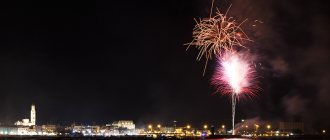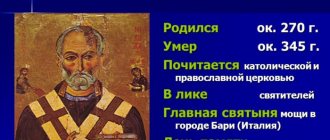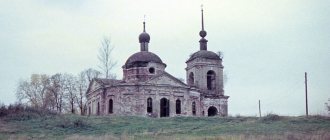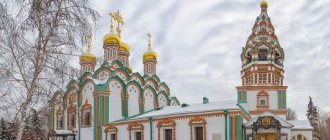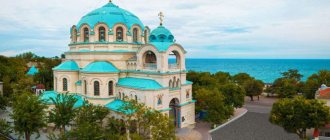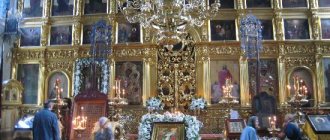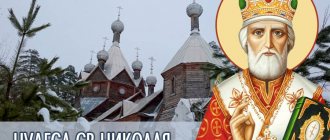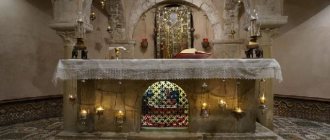The Church of St. Nicholas in Pyzhi is located in Moscow, between Bolshaya and Malaya Ordynka streets, it is one of the oldest buildings in Zamoskvorechye. Belongs to the Moskvoretsky deanery of the Moscow city diocese of the Russian Orthodox Church. It is an architectural monument of the 17th century, having the status of an object of cultural heritage of the peoples of the Russian Federation, of federal significance.
The time of construction of the Church of St. Nicholas of Myra in Pyzhi differs in several documents. The book “Historical Index of Moscow Churches” by local historian and historian Mikhail Alexandrovsky indicates that the temple was built in the period from 1647–1657. In another work “Moscow. A detailed historical and archaeological description of the city by Russian architect Alexei Martynov indicates a different date - 1670.
The church was built in the traditional Russian patterned style of that time. The building has a quadrangular shape with three-part altar projections and is pillarless; its vaults and dome are supported only by the outer walls. The windows are located in two horizontal rows. The chapels of the church are extended to the southeast and northeast of the cube of the main building, which makes it possible to form a single line of altar projections with the altar projection of the main building. The snow-white church is decorated with brick details.
The arched doorway to the refectory is decorated with carved garlands and columns. The window frames of the northern facade are distinguished by a delicate and complex pattern. The pyramid of five domes looks very beautiful. Nearby there is a three-tiered tented bell tower, the entrance of which is decorated with a “hanging” weight. It has 16 dormer windows so that the ringing of bells can be heard throughout the area. The original decoration of the church has been lost. The iconostases now installed in the temple are made in the Old Russian style.
© Nadir Chanyshev
Schedule of services at the Church of St. Nicholas in Pyzhi
On Sundays, as well as during patronal and great holidays, Divine Liturgies are held at 07:00 and 10:00 in the Church of St. Nicholas in Pyzhi.
On other days, the Divine Liturgy is celebrated at 7:30 or 08:00. Evening worship begins at 18:00.
Schedule of the Church of St. Nicholas in Pyzhi
Divine services are conducted in Church Slavonic. During the festive prayer service on Sundays, reliquaries containing relics are brought out of the altar. The rector of the temple is mitered archpriest Alexander Shargunov.
© Victor Boyarsky
Where else to venerate the relics of St. Nicholas the Wonderworker in Moscow
The queue to the relics of St. Nicholas the Wonderworker in the Cathedral of Christ the Savior in Moscow is increasing every day; now pilgrims stand at the relics for an average of four hours. In which churches in the capital and Moscow region are constantly kept particles of the relics of St. Nicholas, and what is unique about the shrine from Bari, read in the RIAMO material.
How to get to the relics of St. Nicholas the Wonderworker in Moscow>>
The queue will grow
© RIAMO, Anastasia Osipova
The arrival in Moscow of the relics of St. Nicholas the Wonderworker, which have been open to pilgrims since May 22, aroused the interest of a huge number of believers. Despite the fact that the relics of the saint will remain in the capital until July 12, residents and guests of the capital do not put off going to the temple until later. Over seven days, more than 156 thousand pilgrims bowed to the shrine.
On Monday morning, the queue to the Cathedral of Christ the Savior increased to 2 kilometers and stretched further beyond the border of the Crimean Bridge.
According to a study by VTsIOM, 72% of Russians want to venerate the relics of Nikolai Ugodnik. Most often, according to the survey, the saint is asked for health, help in personal matters and peace.
From the Park of Culture to the Temple: life inside the queue to see St. Nicholas the Wonderworker>>
Unique shrine
© RIAMO, Anastasia Osipova
As the head of the press service of the Patriarch of Moscow and All Rus', priest Alexander Volkov, told RIAMO, there is a tradition of dividing and bringing parts of the relics so that they are available to believers in different cities and countries. Over the centuries, the relics of various saints were collected in large spiritual centers. For example, the Athos monasteries contain many such relics, which the monasteries share with temples and churches.
Spiritual gifts have been collected in Moscow churches for many centuries, among them there are particles of the relics of St. Nicholas the Wonderworker.
“Each particle of the relics has its own story. In this case, it is important that in the Cathedral of Christ the Savior there is part of the relics of St. Nicholas from the shrine, from which parts have never been separated before. Therefore, this is a unique part of the relics,” explains Father Alexander.
According to him, all the small particles of the relics of St. Nicholas the Wonderworker, which are kept today in different churches of the capital, most likely trace their history back to Myra Lycia in present-day Turkey, where they were located before they were transferred to Bari.
As the priest recalled, the arrival of the relics in Russia became possible thanks to an agreement between Patriarch Kirill of Moscow and All Rus' and Pope Francis and is a gesture of goodwill on the part of the Roman Catholic Church.
Unlike small particles of relics that are kept in the capital's churches, the relic brought from Bari is myrrh-streaming and represents the rib of St. Nicholas.
“Orthodox people greatly revere St. Nicholas. This is one of the most dear and beloved saints. Therefore, the opportunity to meet the saint at his relics is a gift and a great event for any believer,” says Father Alexander.
According to him, despite the fact that particles of the saint’s relics are also in other churches in Moscow, the opportunity to venerate the relics from Bari, to which people from all over the world come, is unique.
Father Alexander reminded the believers that they need to ask the saint for help with a pure heart and good thoughts. The saint will definitely hear such a request.
Pilgrims told why they go to the relics of St. Nicholas the Wonderworker >>
25 churches in Moscow
© RIAMO, Anastasia Osipova
Believers who, for various reasons, will not be able to get to the relics of St. Nicholas the Wonderworker in the KhHS can visit one of the 25 churches in the capital, where particles of the relics of St. Nicholas are permanently kept.
Central District (CAO)
Sretensky Stavropegic Monastery (Bolshaya Lubyanka St., 19)
John the Baptist Convent (Maly Ivanovsky lane, 2A, building 1)
Novodevichy Convent (Novodevichy Proezd, 1, building 2)
Epiphany Cathedral in Elokhov (Spartakovskaya St., 15)
Church-Museum of St. Nicholas in Tolmachi at the Tretyakov Gallery (Maly Tolmachevsky lane, 9)
Church of All Saints on Kulishki (Slavyanskaya Square, 2). Here to the particles of the relics of St. Nicholas can be touched on Thursdays after the end of the Divine Liturgy from 11.00 until the end of the evening service.
Church of St. Nicholas on Three Mountains (Novovagankovsky lane, 9). You can venerate the relics of St. Nicholas the Wonderworker on Sundays during the liturgy, when the ark with the relics is taken out of the altar.
Church of St. Nicholas in Kotelniki (1st Kotelnichesky lane, 8, building 1). A particle of the relics is kept in a silver pendant in front of the icon of St. Nicholas, you can venerate the shrine at any time, akathists to St. Nicholas is read on Thursdays.
Church of St. Nicholas in Stary Vagankovo (Starovagankovsky lane, 14)
Church of the Great Martyr St. George the Victorious in Starye Luchniki (Lubyansky Proezd, 9, p. 2). A piece of the relics of St. Nicholas is kept in a special reliquary, which is inserted into the icon of St. Nicholas.
Church of St. Nicholas of Myra in Golutvin (1st Golutvinsky lane, 14)
Church of St. Nicholas in Pokrovsky (Bakuninskaya St., 100)
Church of St. Nicholas in Khamovniki (Lva Tolstoy St., 2)
Church of the Ascension of the Lord on Gorokhovoy Pole (Radio St., 2)
House church in honor of the Nativity of St. Nicholas, World of the Lycian Wonderworker of the Russian Cultural and Educational Foundation of St. Basil the Great (B. Vagankovskaya St., 3)
Church of the Resurrection of the Word on the Uspensky Vrazhek (Bryusov Lane, 15/2)
Southern District (South Administrative District)
Danilov Holy Trinity Monastery (Danilovsky Val, 22)
Western District (JSC)
Church of the Savior Not Made by Hands on Setun at the Kuntsevo Cemetery (Ryabinovaya St., 18)
Church of the Archangel Michael in Troparevo (Vernadsky Avenue, 90)
Eastern District (VAO)
Church of the Resurrection of Christ in Sokolniki (Sokolnicheskaya Square, 6)
Church of the Assumption of the Blessed Virgin Mary in Kosino (Bolshaya Kosinskaya street, 29, building 3)
Temple of St. Zosima and Savvaty of Solovetsky miracle workers in Golyanov (Baikalskaya St., 37A)
South-Eastern District (SEAD)
Nikolo-Perervinsky Monastery (Shosseynaya St., 82)
Church of the Holy Apostles Peter and Paul in Lefortovo (Soldatskaya St., 4)
South-Western District (South-Western Administrative District)
Church of the Apostles Peter and Paul in Yasenevo (Novoyasenevsky Prospekt, 42)
Moscow region
Nikolo-Ugreshsky Monastery (Dzerzhinsky, St. Nicholas Square, 1)
7 interesting facts about St. Nicholas the Wonderworker>>
Shrines
The temple has a reliquary in the shape of a cross, which contains the relics of seventy-two saints of the Universal Church. List of main shrines:
- Myrrh-streaming image of the passion-bearer Tsar Nicholas II;
- Particles of the relics of John the Baptist;
- Icon of the Holy Royal Martyrs. The reliquary of the shrine contains the milk tooth of Tsarevich Alexei;
- Particles of the relics of the Apostle Andrew the First-Called;
- Particles of the relics of the Apostle Luke;
- Particles of the relics of the Apostle Mark;
- Particles of the relics of St. Silouan of Athos;
- Particles of the relics of Righteous Anna;
- Particles of the relics of the prophet Isaiah;
- Particles of the relics of Equal-to-the-Apostles Princess Olga;
- Particles of the relics of Archdeacon Stephen.
© Official Facebook group of the Church of St. Nicholas in Pyzhi
Story
The Streltsy Regiment of Vasily Filosofov was formed in the 1650s. Then Bogdan Pyzhov became its head in 1668. It was at the expense of his archers that the stone church of Streletskaya Sloboda was built, as this temple was previously called. Initially, there were two chapels in the church: the first - in honor of St. Nicholas, consecrated in the name of the Annunciation, the second - in honor of the Monks Theodosius and Anthony of Pechersk. In those days, it was customary to name churches by their aisles; then the temple was known as Nikolsky.
In 1692, a refectory and a bell tower were added to the building. Until that time, the chapels of the temple were located in its side apses. Over time, they were enlarged with superstructures and they themselves became independent chapels. Another one, the Nikolsky chapel on the south side, was built in 1811. In the same year, the refectory was remodeled, which as a result received its current appearance. Its decoration has only been partially preserved, including a cornice and a small window.
During the Patriotic War of 1812, enemies destroyed the church. In the 19th century, the church was rebuilt and renovated twice. In 1858, money for its restoration was allocated by the merchant I. Lyamin, with these funds a new iconostasis was made, which has not survived to this day. The second reconstruction was carried out in 1895, with the money of his wife.
In 1922, during the years of Bolshevik power, gold and silver church items weighing more than 20 pounds were confiscated from the temple. Unique church utensils from the 17th century, decorated with precious stones, were lost. In 1930, the temple was closed and underwent reconstruction. The bell, which hung in the bell tower of the Church of St. Nicholas in Pyzhi, was transferred to the Bolshoi Theater, where it was used in some productions. Now this bell is installed in the Church of the Epiphany in Elokhov, but on it you can see an inscription indicating that it belongs to the Church of St. Nicholas in Pyzhi.
© Sukhikh Nikolay
Also in the 1930s, during the requisition, the icons of the temple were given to the funds of the Tretyakov Gallery and other Moscow museums. In the 1960s, the temple was again rebuilt for secular needs. There were sewing workshops, a dormitory and even the Research Institute of Construction Materials here.
The temple was returned to the control of the Russian Orthodox Church in 1990. Two years later, in 1992, the first services began to be held here. From 1992 to 2003, icon painter I. Klimenko created new iconostases. Several 19th-century paintings have been preserved in the southern aisle of the church.
In 1993, the third altar was consecrated in the church, in honor of the Hieromartyr Vladimir, Metropolitan of Galicia and Kyiv. The rector of the Church of St. Nicholas of Myra in Pyzhi, Alexander Shargunov, is the head of the committee “For the moral revival of the Fatherland.” The main task of this organization is to combat the propaganda of Satanism and debauchery in Russia.
St. Nicholas churches of old Moscow
| 'Church |
In old Moscow, there were a huge number of churches consecrated in the name of the most revered saint in Rus', St. Nicholas the Wonderworker, both those that have survived to this day and those that were destroyed under Soviet rule.
Among the latter, we will remember the most famous church of St. Nicholas "Big Cross", which stood at the very beginning of Ilyinka and was founded there even before the construction of the Kitai-Gorod wall in the first half of the 16th century. In it, citizens who had litigation were sworn in - “kissed with the cross” - and in the temple, according to the vow of its creators, a huge cross with particles of holy relics was erected. One of the currently operating churches of St. Nicholas the Wonderworker is located on Bersenevskaya embankment near the chambers of Averky Kirillov. Recently restored, it looks like a gingerbread house. Its current building was erected in the 17th century, but the church itself appeared here much earlier. Throughout its history, the church has been connected with both this legendary house and this ominous place. In the dark medieval times of Ivan the Terrible, and during the Soviet hard times, it remained here the only stronghold of the Orthodox faith, and the refuge of the Muscovites who lived here - maybe that’s why the church miraculously survived. We have already mentioned it in an essay about the history of the Church of the Praise of the Virgin Mary, which stood on the opposite bank of the Moscow River next to the Cathedral of Christ the Savior (see our publication dated April 12 of this year)
| Church of St. Nicholas the Wonderworker, in Bersenevka. Photo: hram.codis.ru |
The very name of the area - Bersenevka - already evokes a gloomy memory of a Moscow boyar executed in distant times.
In the 16th - 18th centuries. here was the “Berseneva Lattice,” that is, a night outpost, locked and guarded by watchmen who kept order in the city. During the reign of Ivan III, boyar I.N. was responsible for guard duty in this area. Bersen-Beklemishev, whose name is also given to one of the Kremlin towers - Beklemishevskaya, because his courtyard was located next to it. Somewhere there, near the Moscow River, the boyar was executed in 1525 - because of careless and bold sincerity with Grand Duke Vasily III. They also said that before his death, the disgraced boyar moved from the Kremlin with his entire courtyard to Bersenevka. However, another, less substantiated version says that the name of this area comes from the Siberian word “bersen” - gooseberry, which could grow in the nearby Sovereign Garden on Sofiyka. It was defeated by the order of Grand Duke Ivan III in 1493, when the entire Zarechye region opposite the Kremlin burned down in a fire, and the sovereign ordered that only a garden be built there, without residential buildings, in order to prevent fire in the city in the future.
Already at the end of the 14th century, here, in the Bersenevka area, there was a monastery called Nikola the Old, which is “on the Swamp” - this marshy area received this name due to the constant floods of the Moscow River and heavy rains, which turned the right bank part of the city into a swamp until The Vodootvodny Canal was built in 1786.
Apparently, from those times, from the ancient monastery, the St. Nicholas Church remained on Bersenevka - it is even possible that it was formerly the cathedral church of this monastery or one of its churches. The church was mentioned back in 1475, when it was wooden, and in 1625 it was called “The Great Wonderworker St. Nicholas behind the Berseneva Lattice.” And Moscow kept the memory of the Zamoskvorechsky, or, as they used to say in the old days, Zarechensky monastery for a long time - rumor claimed that it was in it that Ivan the Terrible imprisoned the disgraced Metropolitan Philip. And it was as if people from all over the capital flocked to the Swamp and crowded around the walls of the martyr’s prison. In fact, the metropolitan was kept under arrest in the Epiphany Monastery of Kitai-Gorod, and the legend about Bersenevka appeared due to rumors about Malyuta Skuratov. Rumor connected the red chambers adjacent to the church with his name - as if the chief guardsman himself lived in them, to whom the gloomy house passed from that same boyar Bersen.
The ancient part of these chambers actually dates back to the 16th century, and it is possible that secret and bloody reprisals against those displeasing the king took place here. In 1906, during the construction of an electrical station here, not far from the future House on the Embankment, ancient underground rooms were discovered - so high that a horse could fit in them, as evidenced by the bones discovered there. In the gloomy dungeons, human remains and many vices were found, and soon silver coins from the time of Ivan the Terrible were found nearby. These were probably the torture dungeons of Malyuta Skuratov, who lived somewhere nearby. However, in Soviet times, the grave of a guardsman was discovered on the opposite bank of the Moscow River, near the Church of the Praise of the Virgin Mary, which left historians with a new mystery - after all, in those days the dead were buried only in their church parishes, which means that Skuratov did not live on Bersenevka, but directly opposite her.
One way or another, only Bersenevka in Moscow rumor was closely connected with Malyuta Skuratov. Another legend says that after Skuratov the house passed to his son-in-law, Boris Godunov - the tsar was married to Malyuta’s daughter.
Only from the middle of the 17th century the house and church on Bersenevka have a truly known history. In 1657, Duma clerk Averky Kirillov, who was in charge of the royal gardens in Zamoskvorechye, built himself an estate from the old chambers. At the same time, he rebuilt the beautiful church with the main altar, consecrated in the name of the Holy Trinity, and with the St. Nicholas chapel, which became his home church. In 1695, after the death of the clerk, a 1,200-pound bell appeared on its bell tower, cast by Ivan Motorin himself - 42 years later, he and his son would cast the infamous Tsar Bell in the Kremlin.
The construction of the chambers took a long time - work was still going on at the turn of the 17th-18th centuries. It is believed that the famous M. Choglokov, the architect of the Sukharev Tower, took part in the creation of their final form. However, another, more accurate version names Ivan Zarudny as the author of the chambers - due to the similarity of the decor of the Bersenevsky chambers with the elements of his Menshikov Tower, built later.
After the death of Tsar Fyodor Alekseevich, Averky Kirillov sided with the Naryshkins and fell into the circle of courtiers whom the Miloslavskys planned to destroy. And the clerk was killed along with Artamon Matveev during the Streltsy riot of 1682: he was thrown from the Red Porch to the ground, chopped up, and the corpse was dragged to Red Square shouting: “Make way, the Duma is coming!” He was buried here, on Bersenevka, in the parish of his home church.
His son Yakov was also at first a Duma clerk, and then became a monk at the Donskoy Monastery. The Kirillovs donated a lot to this monastery - it was with their funds that the monastery’s red walls with beautiful towers were built.
Since 1756, the house on Bersenevka began to belong to the treasury: at first the Senate archive was located here, then the Senate couriers lived in it, and the house was called “Courier”. In the 60s of the 19th century, the former Kirillov house was donated by the government to the Moscow Archaeological Society, which held its famous public scientific meetings there.
From the middle of the 18th century, the church became an ordinary parish church. In 1812, it was damaged by fire - it was “burned” and restored, and was re-consecrated the following year after the expulsion of Napoleon.
At the end of the 1920s, a dormitory for the builders of the House on the Embankment was located in the former chambers of the Duma clerk. And in the 30s, in the basement under the closed St. Nicholas Church, ancient icons and the skeleton of a girl with a braid and woven ribbon, walled up in a niche, were found. No one else was able to see the terrible discovery - when the stone slab was opened, the ashes instantly scattered.
In 1930, after the closure of the Zamoskvorechsk church, they immediately began to seek its demolition: in the same year, the bell tower was destroyed because it “darkened out” the premises of the neighboring restoration workshops. The reason for the demolition was, of course, different - the notorious architect Boris Iofan was especially concerned about the liquidation of the church on Bersenevka, who built an entire architectural ensemble in that place - the Palace of the Soviets and the House on the Embankment - as an example of a socialist “house-city” in the style of constructivism. According to the original design, the House was supposed to be in harmony with the Kremlin and was supposed to be red-pink in color. But fate decreed otherwise, and the house turned out to be gloomy gray.
The tragedy of Bersenevka continued in the ominous House on the Embankment - rumors spread that it was built from cemetery slabs from graves devastated by the Bolsheviks, and that is why the fate of its many residents was so unhappy. These were mainly members of the Soviet government, ministers and their deputies, marshals and admirals, on whose heads the ax of Stalinist repression fell in the 30s. Only a few of them escaped execution and camps. Even the “peace” of the residents of the house was guarded by the military instead of concierges, and guard dogs were kept in small basement-windows on the first floor.
They began to dismantle the ancient St. Nicholas Church - there was no place for it in such proximity to the new ideological center of the Soviet capital. And then the construction of the Palace of Soviets was suspended, and the temple miraculously survived. In 1958, a research institute for museology was opened there, and its restoration began in the 70s.
Divine services there were resumed in 1992. At the Feast of the Transfiguration of the same year, a prayer service for peace in Abkhazia was served in the church. Currently the temple is operational.
| Church of St. Nicholas the Wonderworker, called [Red Bell]. Photo from the book by N.A. Naydenova [Moscow. Cathedrals, monasteries and churches]. 1882-83 |
Another wonderful and very ancient, but, unfortunately, closed St. Nicholas Church in Moscow is located in Kitay-Gorod (formerly Yushkov Lane, in Soviet times - Vladimirov Passage, and since 1992 - Nikolsky Lane).
It is called “Red Ringing”, or “at the red bells” - from the “red”, beautiful ringing of its bells. In the old days there was a well-known saying: “Eat bread and salt, listen to the red ringing of Mother Moscow,” and the Kitaygorod St. Nicholas Church, like Moscow, was famous for its bells. The church certainly belongs to the oldest Moscow churches. Previously, there was a chapel in the name of St. Zosima of Solovetsky, and this led researchers to the idea that this church, so close to the Kremlin, was founded by Metropolitan Philip himself in 1566 - in memory of the peaceful days of his stay in the Solovetsky monastery. And when the saint fell into disgrace, Ivan the Terrible, in a rage, ordered the reconsecration of the Kitai-Gorod church, which was renamed in honor of St. Nicholas the Wonderworker. And when Metropolitan Philip was canonized, and his relics were solemnly greeted in Moscow, then during the next renovation of the temple at the end of the 17th century, S.G. Naryshkin, honoring the memory of the saint, again built a chapel in St. Nicholas Church in honor of the Solovetsky saints Zosima and Savvatia.
Another story says that this church appeared here back in 1561, made of stone, through the diligence of an ordinary Chinatown merchant Grigory Tverdikov, and some even attribute his life to the next, 17th century. The usual confusion of history.
In the 17th century, the St. Nicholas Church was called “what is known at the Red Bell Towers on Posolskaya Street” - the Ambassadorial Courtyard was then located here. Its main altar was consecrated in the name of the Nativity of the Virgin Mary, and here was a priceless shrine - the icon of Hodegetria written by Simon Ushakov.
This temple was famous for the fact that, according to legend, the head of the rebel Alexei Sokovnin, the head of the Konyushenny Prikaz, who in 1697 participated in a conspiracy by supporters of Princess Sophia against Peter I and was executed for that, was buried there. His relatives demanded the remains, but the authorities sent the body to a “poor house”, and only the severed head was buried with honors.
In 1858, the church, which had been rebuilt several times by that time, was completely dismantled and, through the efforts of the merchant Polyakov, a new temple was built, which has survived to this day. Perhaps its architect was the famous N.I. Kozlovsky, who built the Church of All Who Sorrow Joy in Kalitniki - he certainly made the iconostasis of the new St. Nicholas Church.
And the most interesting page in the history of St. Nicholas Church is connected with its “red” bells. From the old Moscow name of the church came a legend that its bells, astonishingly in Moscow, were painted red, but this is just a fiction: it would be absurd to cover the sacred bells with paint, especially since bells in Rus' were sometimes beautifully gilded. That's what they were called - gilded. And there were also royal bells - large bells, cast by the highest decree, or for the main churches, ringing on very important holidays. In the Kremlin, for example, there was another “Tsar Bell” weighing a thousand pounds, which was rarely struck, in the event of the death of the Tsar or Patriarch, slowly and spaced out, three times. It was cast already in the middle of the 16th century and was in a special wooden frame, and then it was cast with the addition of copper, called “Festive” and placed on the Assumption Belfry.
In addition to the royal and gilded ones, there were also prisoners, exiles and bast bells. One of these bells was located in the St. Nicholas Church. Bells taken from the enemy in war as trophies were called captives. The exiles were disgraced or captive bells who were sent to the outskirts of the country: sometimes alone, and sometimes together with people who had fallen into disgrace or captivity. Thus, under Tsar Alexei Mikhailovich, many Poles and Lithuanians were exiled to remote Russian provinces, and along with them their captive bells. Bast bells were called disgraced bells, first broken by decree and then tied with bast (however, some believe that these were ordinary bells of a simpler finish.)
In the St. Nicholas Church, one captive bell was placed, taken under Tsar Alexei Mikhailovich during the war with Poland: cast in 1575, with the image of three lilies and with an ancient inscription in a foreign language: “All hope is for the bell from Shen in France” - this is how it was presented translation in the form of a working hypothesis by modern specialists. This captive bell was “lucky” - it was not sent to some distant exile, but remained in the capital city of Moscow, and even on the beautiful central church. After the closure of the St. Nicholas Church in 1927, it was transferred to a museum in the village of Kolomenskoye.
The ringing of bells in Rus' invariably accompanied all great celebrations and marked both joyful and sad events. The ringing of bells called the Orthodox people to church services, and it encouraged those who could not come to church to internal prayer. And according to the church charter, the ringing of bells during Holy Week was called red. Here, in the St. Nicholas Church, located close to the Kremlin, all the bells were matched “to the same tone, and the sound from them was pleasant,” wrote one of the distant contemporaries who heard its ringing. Therefore, this church was also called “at the good bell.”
At the end of 1922, the St. Nicholas Church was seized by some “Free Labor Church”, in 1925 it was slated for demolition, and two years later it was closed, but miraculously survived. At one time it even housed an electrical substation. The church was not under state protection, and it was only included in the list of objects proposed for this production.
